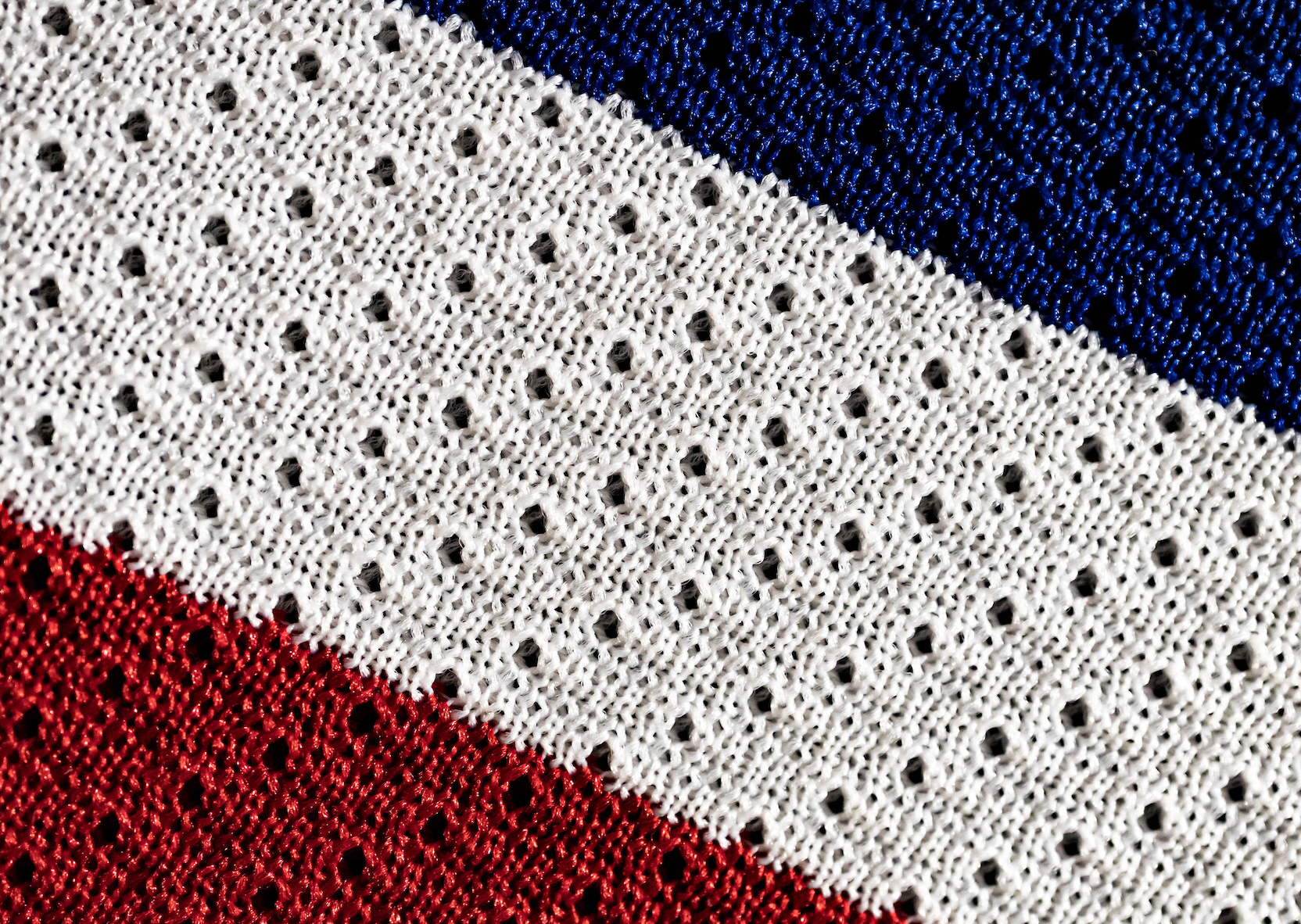Are you considering making custom embroidered outfits with jersey fabric? If so, keep reading to discover if jersey is the best material for your goals. Our article will reveal everything worth knowing about jersey fabric, including the types, features, uses, and benefits. Before we begin, let’s quickly clarify what jersey fabric is.
What Is Jersey Fabric?
Jersey is a soft and close-knit fabric used for making everyday clothing and underwear. Many top designers also use the fabric to make high-fashion clothing.
Originally, wool was the only material used to make jersey fabric. Today, you can find jersey fabrics that contain cotton and other organic materials. Synthetic jersey fabric options made with polyester, viscose, and other inorganic materials are also available.
Jersey Fabric Characteristics
Jersey and natural cotton fabrics have many similar qualities, such as high breathability and moisture-wicking. Other characteristics of jersey fabric include:
- Elasticity: The close-knit construction of jersey-knit fabric enables it to stretch and hug the body. The stretchiness of the fabric minimizes resistance and chafing during movement. If you want jersey fabric clothing with the highest elasticity, opt for designs that incorporate spandex.
- Softness: Jersey fabric has a plush and smooth texture. The pleasant feel of the material ensures superior comfort in all weathers. Despite its softness, jersey-knit fabric is resilient.
- Denseness: Jersey-knit fabric is so closely knit, light cannot penetrate the material. Such fabrics minimize the heat and harmful UV rays that reach the wearer’s skin.
- Lightweight: Jersey is not a heavy fabric, yet, it provides reasonable insulation during winter. However, note that wool jersey knits are heavier than other jersey fabric types.
- Coolness: Jersey fabrics, especially cotton jersey, facilitate air circulation over your skin. The air circulation evaporates sweat and keeps you cool on hot days.
- High Absorption: Jersey absorbs moisture and dries quickly due to its breathability. The feature makes the fabric ideal for base layer clothing and underwear.
- Durability: One of the most impressive jersey fabric characteristics is its ability to recover its original shape after stretching. The stretchiness of the material also makes it tear and wrinkle-resistant.
How Is It Made?
Jersey fishers from the Channel Islands were among the first to wear clothing made from jersey fabrics. Even though the fabric has existed since the 19th century, it wasn’t until 1916 that jersey fabric became mainstream, thanks to Coco Chanel. The fashion mogul brought the fabric to the public’s attention by using jersey materials to create high fashion for women.
Current manufacturers create jersey fabrics from various natural and synthetic fibers. Natural cotton jersey fabrics are more breathable and comfortable, while synthetic fiber jersey is more durable. Manufacturers take the best of both worlds by blending synthetic and cotton fiber fabrics.
While most small-scale producers make jersey fabrics by hand, large producers use flat and circular knitting machines. Creating the close-knitted fabric requires specialized needles and hooks or knitting machines that intertwine a single yarn to form side-by-side loops in a single row. The loop rows create vertical lines on the front of the fabric and crosswise rows on the back.
Types of yarn commonly used to knit jersey fabric include:
- Cotton
- Wool
- Viscose (Rayon)
- Polyester and Polyamide
What Kind of Fabric Is Jersey?
Depending on the yarn blend, jersey can be a light-to-medium weight fabric. Most jersey fabrics are soft, opaque, and drape over the body to create a comfortable fit. Since the material is highly versatile, it is suitable for male, female, and baby clothing for winter or summer. You can also create jersey fabric scarves and bedding.
Types of Jersey Fabric
How Many Types of Jersey Are There?
Two main types of jersey fabric are available – single and double jersey. Weaving single jersey fabric requires only one set of needles, while double jersey requires two different needle sets. The front and back of a single jersey look different, while both sides of a double jersey look the same. Also, double jersey fabrics are thicker and pricier.
Single Jersey Types
Single or plain knit jersey options include:
- Viscose Jersey: The single-knit material may contain a viscose and elastane blend. Both are soft, stretchy, and lightweight materials that drape nicely, making them suitable for fitted or loose tops, trousers, and dresses.
- Polyester Jersey: It has a silky and warm feel. Since polyester is lightweight and stretchy, it’s suitable for close-fitting garments, such as sportswear.
- Cotton Jersey: It is soft and feels warm on the skin. Light and medium weight variations are available for loose-fitting t-shirts, dresses, and nightwear. Note that cotton jersey isn’t as stretchy as viscose, elastane, or polyester.
- Cotton and Elastane Mix Jersey: Since the blend contains about 3% elastane, it’s stretchier than plain cotton jersey. It’s also thicker than viscose and polyester, making it ideal for leggings, underwear, and dresses.
- Sweater Knit Jersey: The material is heavy and less stretchy because it contains a blend of cotton, wool, and similar yarns. Sweater knit typically feels soft and warm with a spongy surface texture.
Double Jersey Types
Double or interlock jersey consists of two pieces of single jersey knit together, creating a smooth surface on the front and back. Popular variations of double knit jersey fabrics include:
- Ponti (Ponti di Roma): It contains a polyester, viscose, and elastane blend. It’s slightly stretchy and doesn’t drape much, making it suitable for formal skirts, trousers, and dresses.
- Interlock Jersey: Its 100% cotton content makes it thick, stable, and hypoallergenic. The fabric’s stretchiness, comfort, and breathability make it a top choice for childrenswear, t-shirts, and nightwear.
How Is It Used?
Jersey fabric uses vary depending on the fabric blend. For example, cotton jersey fabric blends are ideal for t-shirts, polos, tank tops, underwear, and bedding. Fashion designers also use viscose and cotton blends to make dresses that accentuate the wearer’s figure.
Viscose and polyester blends are best for high-sweat garments, such as sweat pants and sportswear. That’s because the fabric’s stretchiness facilitates a wide range of motion. Its softness also prevents chafing, and its moisture absorption and breathability ensure coolness while working out.
Lastly, jersey fabrics are suitable for year-round workwear and construction uniforms. The high absorbency and elasticity of the material can prevent worker discomfort. Even better, you can stitch your brand’s logo on jersey fabric workwear.
Is Jersey Fabric Right for Embroidery?
Tightly woven materials like jersey fabric provide some of the best surfaces for embroidery. You can embroider brand names, logos, or other details on natural and synthetic jersey fabrics. However, depending on the yarn blend, you may need to take certain precautions before embroidering.
For example, you should wash cotton jersey before embroidering. Washing the fabric will eliminate shrinkage issues that may negatively affect the finished embroidery. At Thread Logic, we can embroider your preferred design into cotton, wool, or polyester blend jersey fabrics to create your perfect embroidered uniform or workwear.
Our Favorite Jersey Apparel at Thread Logic
Top-selling jersey apparel at Thread Logic include the:
- Port Authority Jersey Knit Polo Shirt: Its material is 50% soft cotton and 50% polyester jersey knit. The shirt is durable, easy to clean, and available in several attractive colors.
- Gildan Ultra Cotton Jersey Polo Shirt: The short sleeve polo shirt’s fabric is 50% cotton and 50% polyester. The material is highly breathable, offering a comfortable fit throughout the year.
- Jerzees SpotShield Jersey Knit Polo Shirt with Pocket: The front pocket adds to the versatility of this cotton-polyester blend polo shirt. Its water and stain-repellant fabric also make it suitable blue-collar workwear.
- Independent Trading Co. Lightweight Jersey Full-Zip Hooded T-Shirt: The durable and comfortable 60% cotton and 40% polyester blend makes this long sleeve shirt ideal for cold seasons.
- Jerzees SpotShield Long-Sleeve Jersey Polo: The cotton and polyester blend and long sleeve design make this shirt appropriate for cooler months. You can get it in seven colors, all protected with SpotShield for easy stain removal.
Shop for Custom Embroidered Jersey Clothing
If you want a fabric that looks and feels good in different weathers, you can’t go wrong with jersey fabric. Opt for thicker fabric, like sweater knit jersey, if you live in colder climes. If it’s usually hot in your area, go for cotton jersey fabric.
Individuals who need stretchy and comfy clothing for exercising or the workplace can try polyester, cotton, or elastane jersey blends. For your custom embroidered polo shirts made with jersey fabric, contact us at Thread Logic today.


